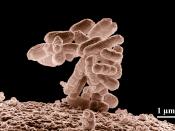Abstract
The purpose in this experiment of growth dynamics of E. coli in varying media was to determine which media produces the maximum number of cells per unit time. First a control was established for E. coli in a 1.0x nutrient broth. This was used to compare the growth in the experimental media of 0.5x and 2.0x, nutrient broths; nutrient broths with an additional 5.0mM of glucose and another with 5.0mM lactose; nutrient broths of varying pH levels: 6.0, 7.0, and 8.0; and finally a nutrient broth in the presence of the drug/antibiotic chloramphenicol. A variety of OD readings were taken and calculations made to determine the number of cells present after a given time. Then two graphs were plotted, Number of cells per unit volume versus Time in minutes and Log of the number of cells per unit volume versus Time growth curve. The final cell concentration for the control was 619,500 cells/mL.
Four media, after calculations, produced fewer cells than that of the control, these were: Chloramphenicol producing 89,301 cells/ml; glucose producing 411,951 cells/mL; lactose producing 477,441 cells/mL and finally pH 6.0 producing 579,557cells/mL. The remaining four media, after calculations, produced cell counts greater than the control: 2X with 1,087,009 cells/mL; 0.5X with 2,205,026 cells/mL; pH 8 with 3,583,750 cells/mL and finally pH 7.0 with 8,090,325 cells/mL. From these results the conclusion can be made that the environment is a controlling factor in the growth dynamics of E. coli. This was found through the regulation of pH and nutrient concentrations. In the presence of the drug/antibiotic, chloramphenicol, cell growth was minimal.
Introduction
E. coli grows and divides through asexual reproduction. Growth will continue until all nutrients are depleted and the wastes rise to a toxic level. This is demonstrated by the Log of the number of cells...


